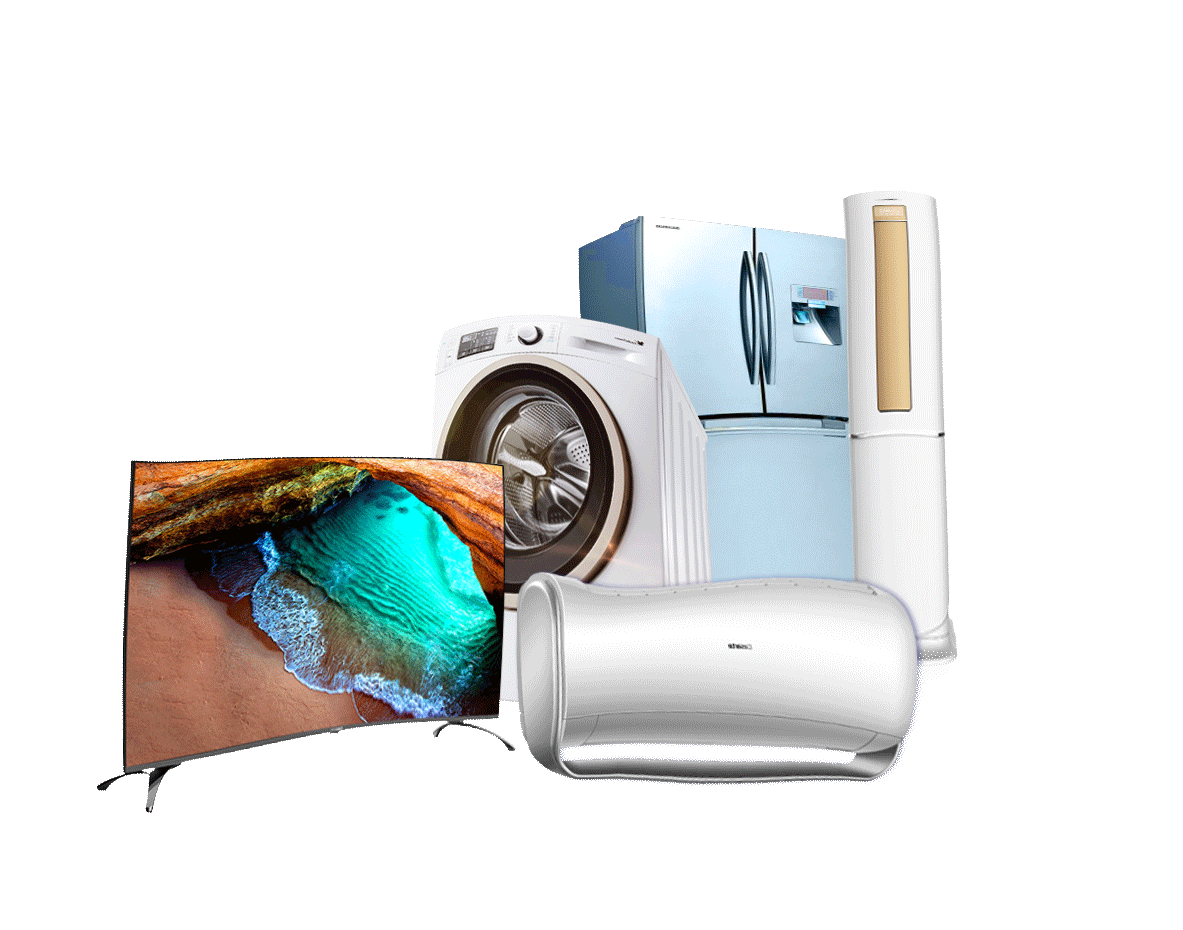Reasons to Buy Canon EF-S 17-85mm f4-5.6 IS USM Lens
Here we’ve included a summary of the advantages and disadvantages of the Canon EF-S 17-85mm f4-5.6 IS USM lens in a list form to help you determine whether it offers the features you need.
PROs
| Optical Image Stabilization |
| Autofocus |
| Distance Scale |
| DoF(Depth of Field) Scale |
| Full-time Manual Focusing |
| Internal Focusing |
Report a correction
Buy Canon 17-85mm f4-5.6 IS USM from or B&H PHOTO
CONs
| No Weather Sealing |
| Hood is not supplied |
| Slow Aperture at Tele end |
| Variable Aperture |
Lens Mount
Canon 17-85mm f4-5.6 IS USM is compatible with cameras that have a Canon EF-S lens mount. Some of the latest released cameras that are compatible with the Canon EF-S lenses are Canon T8i, Canon 90D and Canon SL3.
Size, Weight and Filter Thread
Size and weight is a very important decision factor when searching for your next lens. Canon 17-85mm f4-5.6 IS USM has a maximum diameter of 79mm and total length of 92mm. It weighs 475g / 16.8 oz.
Canon 17-85mm f4-5.6 IS USM has a filter thread of 67mm. Below are links to the filters that we recommend you to consider for your Canon 17-85mm f4-5.6 IS USM:
Optical Image Stabilization
The Canon 17-85mm f4-5.6 IS USM features an optical image stabilization system which helps to reduce the blur that occurs due to shaking during hand-held shooting.
Zoom Method
Canon 17-85mm f4-5.6 IS USM features Rotary (internal) zoom method where the length of the lens doesn’t change while you are zooming in or out. Even though this design has a size disadvantage in general compared to extending designs, it has the benefits of better sealing against dust and moisture, no zoom creep and no weight balance shift while zooming.
Maximum Magnification Ratio
Canon 17-85mm f4-5.6 IS USM has a Max Magnification Ratio of 0.2x and has a minimum focusing distance of 0.35m.
Below are the 3 Standard Zoom type Canon1 mount lens alternatives with highest max magnification ratios:
- Canon 24-70mm f4L IS USM: 0.7x — (Compare)
- Sigma 17-70mm F2.8-4 DC OS HSM: 0.37x — (Compare)
- Canon 18-55mm f3.5-5.6 IS STM: 0.36x — (Compare)
Aperture
Canon 17-85mm f4-5.6 IS USM is a variable aperture lens with a max aperture of f4 and a minimum aperture of f22 at 17mm, and a max aperture of f5.6 and minimum aperture of f32 at 85mm .
| Focal Length | Max Aperture | Min Aperture |
|---|---|---|
| 17mm | F4 | F22 |
| 85mm | F5.6 | F32 |
Optical Formula
Canon 17-85mm f4-5.6 IS USM’s optical formula consists of 17 elements in 12 groups . Special elements used in this design is Super Spectra coatings.
Lens Hood
Canon 17-85mm f4-5.6 IS USM doesn’t come with a lens hood. You have to order the hood separately and the model number of the hood is EW-73B.
Popular Comparisons of Canon 17-85mm f4-5.6 IS USM
Top Alternatives of Canon 17-85mm f4-5.6 IS USM Lens
| Model | Coverage | Weight | Focusing | Street Price | |
|---|---|---|---|---|---|
|
Canon EF-S 15-85mm f3.5-5.6 IS USM Compare |
APS-C / DX | 575 g / 1.27 lb | AF | ||
|
Canon EF-S 18-135mm F3.5-5.6 IS USM Compare |
APS-C / DX | 515 g / 1.13 lb | AF | ||
|
Sigma 17-70mm F2.8-4 DC MACRO OS HSM C Compare |
APS-C / DX | 465 g / 1.02 lb | AF | ||
|
Canon EF-S 18-55mm F4-5.6 IS STM Compare |
APS-C / DX | 215 g / 0.47 lb | AF | ||
|
Canon EF-S 18-200mm f3.5-5.6 IS Compare |
APS-C / DX | 595 g / 1.31 lb | AF | ||
|
Canon EF-S 18-55mm f3.5-5.6 IS Compare |
APS-C / DX | 200 g / 0.44 lb | AF | ||
|
Canon EF-S 17-55mm f2.8 IS USM Compare |
APS-C / DX | 645 g / 1.42 lb | AF | ||
|
Canon EF-S 18-55mm f3.5-5.6 IS STM Compare |
APS-C / DX | 205 g / 0.45 lb | AF |
Design
The 17-85mm is a member of Canon’s family of mid-range zooms, and as such the build quality is a clear step up from the lightweight plastic of the 18-55mm kit lens, if not quite up to the standards of Canon’s professional-level ‘L’ series. The lens mount is metal, and the barrel plastic; unfortunately it’s not quite as solid as Canon’s other mid-range zooms such as the 28-135mm F3.5-5.6 IS USM, and the plastic feels a bit thin and creaky, and deforms a little under pressure, which isn’t terribly reassuring. However to its credit, and unlike the 18-55mm, the 17-85mm does have a proper manual focusing ring and distance scale. At 475g in weight, this lens is also perfectly light enough to carry around with you all day long.
Specific image quality issues
Chromatic Aberration
By far the most problematic aspect of this lens’s performance in real-life shooting is chromatic aberration at wide angle. Strong green/magenta fringing is visible in 17mm shots even at modest magnifications, and stopping down the aperture has no effect. It remains a problem at 24mm, but is much less of an issue at longer focal lengths. This type of chromatic aberration can be ‘corrected’ in software, and particularly efficiently if you’re prepared to shoot RAW. For instance, using our standard converter, Adobe Camera RAW, processing with -30 Red/Cyan and +30 Blue/Yellow effectively eliminated CA.
| 100% Crop, left of frame | 17mm F8.0, EOS 400D |
|---|
Aberration correction using Digital Photo Pro (updated July 2008)
With version 3.4 of their free RAW conversion software Digital Photo Pro (DPP), Canon have added lens aberration correction support for the 17-85mm IS. This allows RAW shooters to eliminate (or at least reduce) the effects of chromatic aberration, falloff (which Canon refer to as ‘peripheral illumination’), geometric distortion, and ‘color blur’ (which appears to be Canon’s term for axial chromatic aberration).
DPP’s aberration correction works by using profiles specific for each lens, making the software fairly straightforward to use, and with no major need to play with the slider settings (except perhaps for the occasional small tweak). Here’s an example of chromatic aberration correction using default settings for the image above; DPP has effectively removed the ugly green and magenta fringing completely.
| 100% Crop, left of frame | 17mm F8.0, EOS 400D |
|---|
The corrections for peripheral illumination and geometric distortion are equally impressive; in the example below we can see clear correction for falloff even at F8 (however in more extreme cases, this will come at some cost to image noise). More importantly, the strong barrel distortion at 17mm is also well corrected; this is most obvious in the bowed line along the lower edge of the frame, but verticals also become properly parallel. Of course there’s no such thing as a free lunch, and this kind of software distortion correction will require some localized ‘stretching’ of the image data resulting in a loss of resolution in affected regions, but overall this is a small price to pay when distortion is otherwise objectionable.
| EOS 400D, 17mm F8 | ||
| Original | Peripheral Illumination | PI + Distortion |
Studio Tests
The 17-85 gives what can only be described as mixed results in our studio tests. Its performance is rather disappointing at wideangle, where it serves up a witch’s brew of corner softness, green/magenta chromatic aberration, barrel distortion and light falloff; however it becomes very much better at telephoto, and in the 35-70mm range is really very good indeed.
| Sharpness | Best results are obtained in the normal to telephoto range, where the lens gives consistently high sharpness readings from 35mm to 85mm. Unfortunately things go downhill towards wide angle, especially in the corners which are distinctly soft at 17mm. The lens appears to be optimized to perform wide open at all focal lengths, and shows no systematic increase in quality on stopping down to smaller apertures; at F11 and beyond the sharpness drops rapidly due to diffraction, as expected. We’d certainly advise against using apertures much smaller than F16, except in those rare cases where extreme depth of field is important. |
|---|---|
| Chromatic Aberration | Chromatic aberration is distinctly worst at 17mm, where the almost-overlapping red and blue lines indicate green-magenta fringing, which is visually the most intrusive (see also the example below). The story is similar at 24mm, but at 35mm and beyond CA becomes much less of an issue. |
| Falloff | We consider falloff to become perceptible when the corner illumination falls to more than 1 stop less than the centre. Once again, the lens gives a poor showing at 17mm, with 1.7 stops of falloff wide open; you’ll need to stop down to around F8-11 to reduce it completely below perceptible levels. However aside from that, there’s nothing too much to worry about, with just a hint of falloff wide open at 24mm. |
| Distortion | The 17-85mm also shows unusually high barrel distortion at wide angles, measuring a whopping 2.4% at 17mm. This is also not ‘pure’ barrel distortion but a more complex ‘wave’-type, with the barrel effect most pronounced towards the centre, then pinched in again towards the edges, which makes it relatively difficult to correct in software. At 24mm and longer the pattern changes to pincushion, and at its worst reaches -1.5% at 50mm; again pretty pronounced, and readily visible if the image should contain straight lines. |
Macro Focus
| A decidedly average performance here, with an image area of 10.5cm x 7cm, equating to a maximum magnification of 0.21x, close to Canon’s specified 0.2x. This is achieved at 85mm and the closest focus distance of 35cm, giving a working distance of about 19cm between the subject and the front of the lens.The image shows strong barrel distortion, soft corners and yellow/blue chromatic aberration; this is a poor result, far worse than the kit 18-55mm and certainly no substitute for a true macro lens. | |
|
Macro — 105 x 70 mm coverage Distortion: Strong barrel Corner softness: Poor Focal length: 85mm (135 mm equiv) |
|---|
Samples Gallery
There are 15 images in the samples gallery. Please do
not reproduce any of these images on a website or any newsletter / magazine
without prior permission (see our copyright
page). We make the originals available for private users to download
to their own machines for personal examination or printing (in conjunction
with this review), we do so in good faith, please don’t abuse it.
Unless otherwise noted images taken with no particular
settings at full resolution. A reduced size image (within 1024 x 1024
bounds) is provided to be more easily viewed in your browser. As always
the original untouched image is available by clicking on this reduced
image.
Lens body elements
| The lens uses Canon’s all-electronic EF-S mount. The ‘S’ designation means it is designed exclusively for APS-C digital SLRs, and the gray rubber ring on the rear prevents it from fitting on 1.3x or full-frame cameras. Owners of Canon’s pre-EF-S era APS-C models (i.e. the D30, D60 or 10D) beware: this lens won’t fit those cameras either. | |
|---|---|
| The filter thread is 67mm. It does not rotate on autofocusing, which should please filter users. | |
| A bayonet-type mount is provided for the petal-style EW-73B hood, but the bad news is that Canon don’t supply this in the box, instead it’s a pricey optional extra. Shame on Canon; I would argue that the lens hood should always be a standard accessory. | |
| The zoom ring rotates 60 degrees anti-clockwise from wide to telephoto. The ribbed rubber grip is 20mm wide, and the zoom action smooth and precise.The front element extends 26mm on zooming, and stays solidly positioned when set to 85mm, with no lateral play whatsoever. It can be made to wobble around a bit at shorter focal lengths, but this is unlikely to be a problem in real-life use. | |
| The 9mm-wide focus ring rotates 90 degrees clockwise from infinity to 0.35m. It does not rotate during autofocus, and the full-time manual system allows tweaking of the focus even when the lens is set to AF. Again the action is smooth and precise; unlike the kit 18-55mm, this is a lens you can manually focus perfectly happily. Very nice. | |
| A distance scale is provided with markings in both feet and meters, but there’s no depth-of-field markings or infra-red correction mark. The focus ring travels slightly past the infinity mark, apparently to allow for the effects of ambient temperature variations. | |
| Two small but positive switches adorn the side of the lens barrel; the lower turns the image stabilizer on or off, and the upper switches between autofocus and manual focus. The IS switch is the larger of the two, and slightly recessed to prevent accidental movement. Both are within easy reach of your left thumb with the camera up to your eye. |
Механические характеристики
Механические характеристики объектива не имеют прямого отношения к качеству изображения, но во многом определяют срок службы объектива, удобство его в использовании, четкость работы автофокуса, стабилизации (в случае ее наличия). Результаты этого теста взяты из подведения итогов об объективах на сайте photozone.ru. Шкала оценок 5-бальная:
- 1 балл — очень плохо
- 2 балла — ниже среднего
- 3 балла — «добротный средний класс»
- 4 балла — очень хорошо, но есть небольшие придирки
- 5 баллов — идеально!
Вот так распределились оценки механической части тестируемых объективов:
Лучшим оказался Canon 15-85, худшим — Canon 18-55.
Подведение итогов
Немного о системе оценки. Место, занятое объективом в той или иной номинации соответствовало баллам, присвоенным объективу. Баллы по всем номинациям складывались. Получалось, что чем меньше итоговый балл, тем лучше. Получается, что баллы «штрафные». Чтобы получить результат, нужно вычесть эти штрафные баллы из какого-то начального числа. Это число было определено таким образом, что китовый Canon 18-55 IS оказался неким «нулевым уровнем», от которого будем дальше отталкиваться. Кроме того, для тестов разных были введены весовые коэффициенты от 1 (то, что можно исправить в редакторе) до 3 (критически важная характеристика):
- Разрешающая способность: 3 (если объектив «мылит», то ни в каком редакторе это не исправишь)
- Хроматические аберрации: 1 (правится в RAW)
- Дисторсия: 1 (правится в RAW)
- Виньетирование: 1 (правится в RAW)
- Механическая часть: 3 (долговечность, удобство в использовании)
- Универсальность (фокусные расстояния): 2 (важная, но субъективная характеристика)
Синий столбец на диаграмме — набранный итоговый балл, чем больше, тем лучше. Красный столбец на диаграмме обозначает среднюю розничную цену (в тысячах рублей) на момент публикации статьи.
А так выглядит «абсолютная шкала», в которой показано, сколько баллов набрал каждый объектив в абсолютном зачете.
Что же, результат в некоторых местах довольно неожиданный. В первую очередь удивила Sigma 18-125 — такого соотношения цена/качество я не ожидал! Технические характеристики объектива вполне сбалансированные — особо выдающихся качеств нет, но и явные минусы тоже отсутствуют, твердый середнячок! Ее соперники по рыночному сегменту — Canon 18-135 и Canon 17-85 ощутимо от нее отстали.
Canon 18-135mm погубила сильная дисторсия, виньетирование и низкая разрешающая способность на длинном конце. Если первые два недостатка можно исправить программно, то третий является критическим. Из сильных сторон этого объектива — самый большой диапазон фокусных расстояний, относительно малые хроматические аберрации и неплохое качество картинки в первой половине диапазона.
Самое слабое места у Canon 17-85 — это сильные хроматические аберрации (даже слишком сильные!) и значительная дисторсия. По разрешающей способности он оказался весьма неплох и ненамного отстал от победителя данного соревнования — Canon 15-85.
Canon 15-85 показал себя как добротный и сбалансированный по характеристикам объектив. Главный его недостаток — виньетирование на коротком конце, однако, это, частично, следствие того, что у него минимальное фокусное расстояние меньше, чем у остальных участников данного соревнования. В остальном, объектив Canon 15-85 подтвердил звание флагмана в своем сегменте.
p.s. Данный анализ был проведен исключительно по результатам лабораторных испытаний, которые можно измерить численно. Предполагается, что все тестовые экземпляры объективов, упомянутых в статье оказались «удачными» — без фронт-бэкфокусов, перекосов ГРИП и т.д. Анализ цветопередачи, бликоустойчивости, рисунка размытия, скоростных характеристик и всего остального не проводился по причине отсутствия исходных данных.
Убедительная просьба не воспринимать данный обзор как руководство к действию («покупайте только объектив A, все остальное отстой!»). Результаты лабораторных испытаний не всегда дают полную картину ситуации. В реальных условиях объективы могут вести себя совершенно по-разному с разными фотоаппаратами. В «синем блоке» ниже по тексту будут приводиться ссылки на отзывы реальных пользователей на данные объективы.
Optical Image Stabilization
The 17-85mm features Canon’s second generation optical image stabilization, which claims to allow handholding at shutter speeds 3 stops lower than usual before blur from camera shake becomes apparent. It’s near-silent in use, with just a quiet whirring noise when operational, and with distinct clicks when it activates and deactivates, presumably due to the lens elements moving in and out of the ‘at rest’ position.
We’ve generally found the units in SLR lenses to be pretty effective in real-world use, and to quantify this, we subjected the 17-85mm to our studio image stabilization test at both wideangle and telephoto. With its effective focal length range of 27-136mm, we’d normally expect to be able to get good results handheld at 1/30 sec at wideangle, and 1/160 sec at telephoto without image stabilization. The subject distance for these tests was approximately 2.5m.
| 17mm IS OFF | 85mm IS OFF |
| 17mm IS ON | 85mm IS ON |
Here we can see clearly the effectiveness of Canon’s in-lens IS unit. At the wideangle end and shutter speeds of 1/6 sec, IS is delivering 70% critically sharp shots, compared to just 20% without. Even at very slow shutter speeds of 0.3 sec, IS is giving usable images with no more than mild blur 80% of the time, compared to just 10% without.
Overall conclusion
The EF-S 17-85mm is a major step up from Canon’s EF-S 18-55mm F3.5-5.6 II kit lens, adding an extended focal length range, image stabilization, fast and silent autofocus with a decent manual focus option, and substantially improved build quality. This makes it, at first sight at least, an ideal all-in-one ‘walkaround’ lens for Canon’s APS-C SLRs, which will cover the majority of photographic opportunities when traveling light.
And to a great extent it delivers on this potential, with good imaging performance over much of its range, especially in that extended telephoto region, plus effective image stabilization which works as promised. But there’s no getting away from this lens’s Achilles’ Heel, which is comparatively poor optical performance at the wideangle end. Most intrusive is the green/magenta chromatic aberration at 17mm, which is highly visible in a wide variety of shooting situations. Now if you’re only planning on viewing files on screen or making small prints, this may not be a huge problem, but if you are making large prints or viewing at 100% it’s a clear issue. However it can be effectively overcome if you are prepared to shoot in RAW and eliminate the CA in post-processing, using either Canon’s Digital Photo Pro (v3.4 or later) or third party software such as Photoshop.
The lens also exhibits significant barrel distortion at 17mm, making it far from ideal for photographing architecture, except perhaps Gaudi in Barcelona, or City Hall and the ‘Gherkin’ in London. And with its relatively slow maximum aperture, this is also not an ideal lens for low light/indoor photography of people or other moving subjects. It’s important to appreciate that while image stabilization will allow hand-holding at slower shutter speeds than usual without suffering image degradation due to camera shake, those shutter speeds are still slow, and moving subjects will therefore still be blurred. Likewise the slow maximum aperture will limit flash range, so for this kind of photography, a faster zoom or prime lens will be a better option.
So overall the judgment to be made is whether the attractive feature set of this lens offsets the negatives, and most importantly the problems with distortion and chromatic aberration at wide angle. If you shoot primarily towards the telephoto end, this lens will reward you with excellent results, but if your interests tend more towards the wideangle end of the spectrum and you don’t want to shoot RAW, then it may well be a good idea to look away now. However overall it must be said this lens is really rather enjoyable to use; the zoom range is very flexible, the autofocus fast and silent, and the image stabilizer highly effective. So in balance its advantages probably outweigh its disadvantages, and despite its faults this lens is ultimately still one of our favorites for Canon’s APS-C dSLRs. Therefore, as long as its limitations are appreciated, it just about earns our recommendation.
| Detail | Rating (out of 10) |
| Build quality | 7.5 |
| Ergonomics & handling | 8.0 |
| Features | 8.5 |
| Image quality | 7.5 |
| Value | 7.0 |
Recommended (with reservations)
CANON 17-85 mm 1:4 — 5.6 IS USM конструкция и логика сборки
Про лейку не впечатлило.Не все разделяют художественную ценность последней.Ну, тогда чистая техника, а чем ещё потренировать мозги в воскресенье вечером.Представим гипотетическую ситуацию.Разобрали вы объектив для замены чего то, и тут вдруг неотложное дело на пару часов.А дело такое, не дай бог, что всё забыли. Ну, не свой день рождения, а всё про объектив.Как собрать с нуля, что придумали хитрые японцы? Как думать по-японски?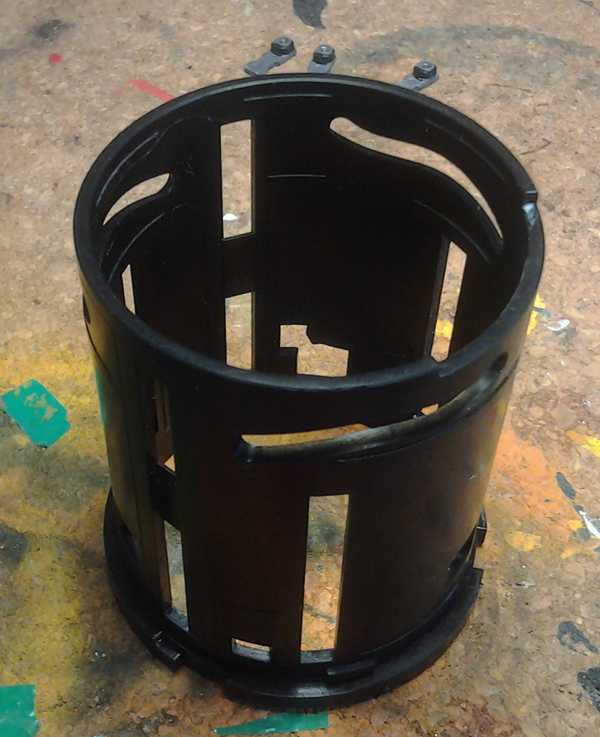 основу объектива составляют баррели, ну да, бочки
основу объектива составляют баррели, ну да, бочки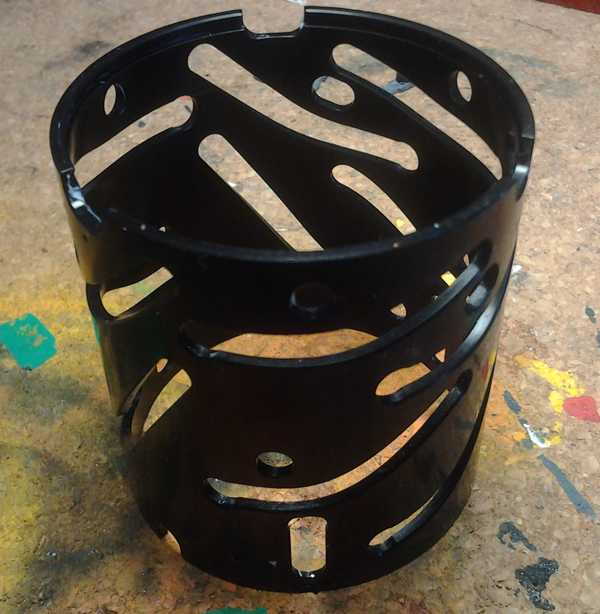 этот красивый очень нежныйкогда объектив упадёт, баррель мало что теряет форму окружности, ещё и пазы теряют постоянную ширинупо пазам ходят втулки и должна быть плавностьремонт без гарантий и очень сложныйэто баррель от зум объектива со стабом поэтому так много прорезей
этот красивый очень нежныйкогда объектив упадёт, баррель мало что теряет форму окружности, ещё и пазы теряют постоянную ширинупо пазам ходят втулки и должна быть плавностьремонт без гарантий и очень сложныйэто баррель от зум объектива со стабом поэтому так много прорезей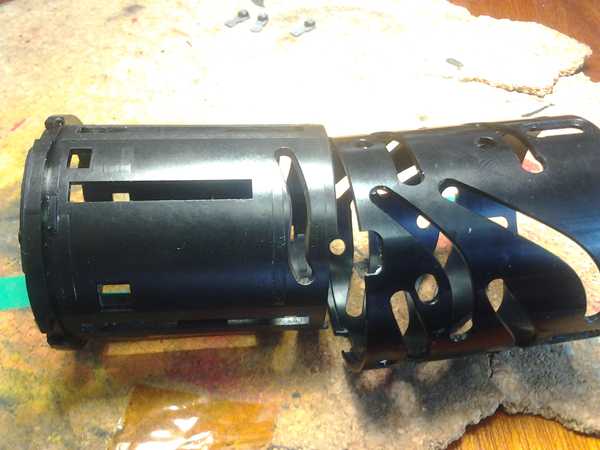 сборку нужно начать с установки одного в другойнужно к чему то привязаться, установить можно тремя способами, три обнижения в ажурном барреле входят в выступы барреля меньшего диаметрапрактически все детали в объективе можно установить тремя способами, но правильный один и хорошо, если вы сразу поставите правильноможно собрать весь объектив, а при установке байонета обнаружить, что поводок диафрагмы не цепляет, ошиблись на 120 градусов
сборку нужно начать с установки одного в другойнужно к чему то привязаться, установить можно тремя способами, три обнижения в ажурном барреле входят в выступы барреля меньшего диаметрапрактически все детали в объективе можно установить тремя способами, но правильный один и хорошо, если вы сразу поставите правильноможно собрать весь объектив, а при установке байонета обнаружить, что поводок диафрагмы не цепляет, ошиблись на 120 градусов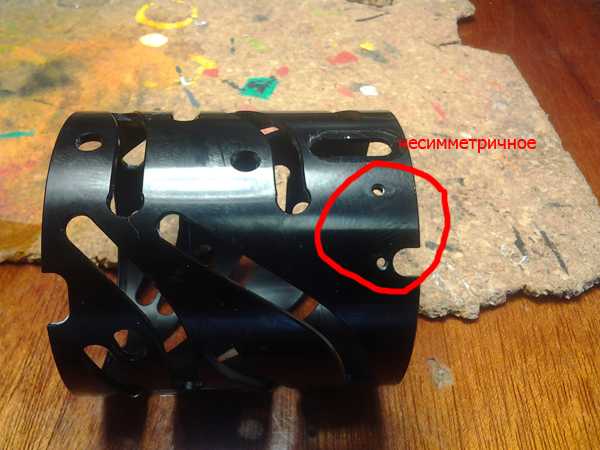 в ажурном есть за что зацепиться, это обнижение и два отверстия под винты
в ажурном есть за что зацепиться, это обнижение и два отверстия под винты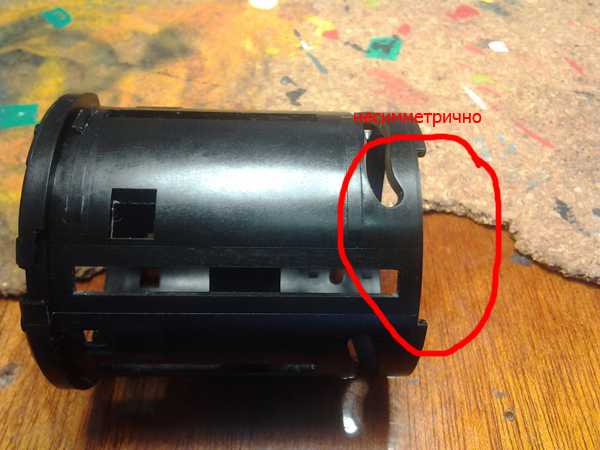 во внутреннем есть длинное обнижение
во внутреннем есть длинное обнижение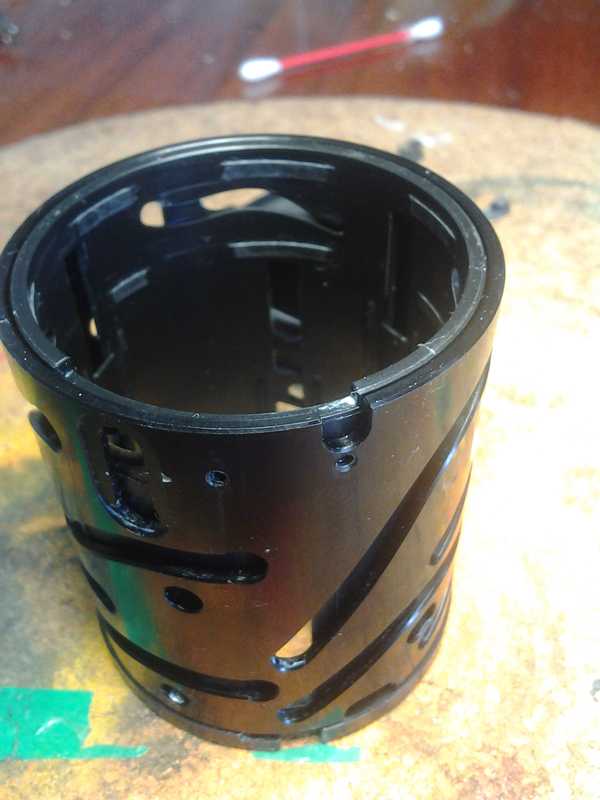 так можно состыковать, пока не понятно для чего, но совпадает
так можно состыковать, пока не понятно для чего, но совпадает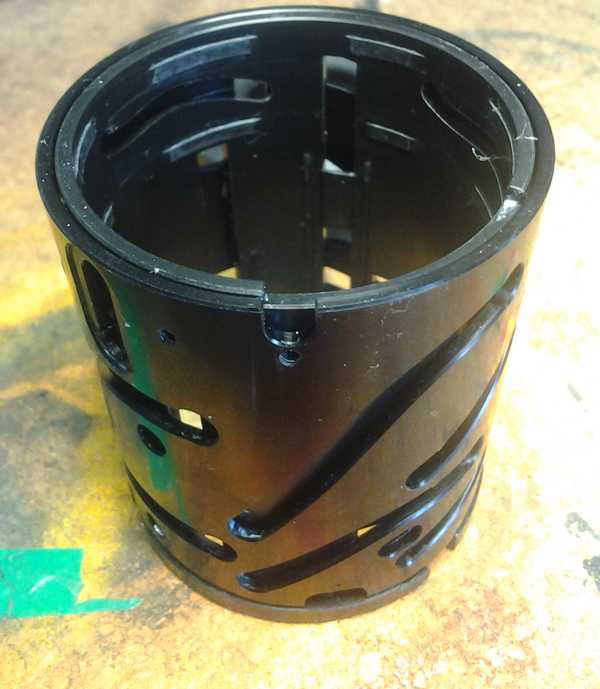 это второе крайнее положениепо логике должен быть паз, который при вращении баррелей один внутри другого должен тоже занимать крайнее положениеничего не понятно, правда?ну да ладно, верим мне на слово, всё равно больше привязаться не к чему, а здесь есть логика
это второе крайнее положениепо логике должен быть паз, который при вращении баррелей один внутри другого должен тоже занимать крайнее положениеничего не понятно, правда?ну да ладно, верим мне на слово, всё равно больше привязаться не к чему, а здесь есть логика находим в коробке такой крючочек и пазл выстроилсяэто рычаг зума, хвостик входит в прорезь наружного кольца, а движение ограничено внутренним кольцомбелое кольцо не считается оно не привязано это геликоид линзы фокусировки
находим в коробке такой крючочек и пазл выстроилсяэто рычаг зума, хвостик входит в прорезь наружного кольца, а движение ограничено внутренним кольцомбелое кольцо не считается оно не привязано это геликоид линзы фокусировки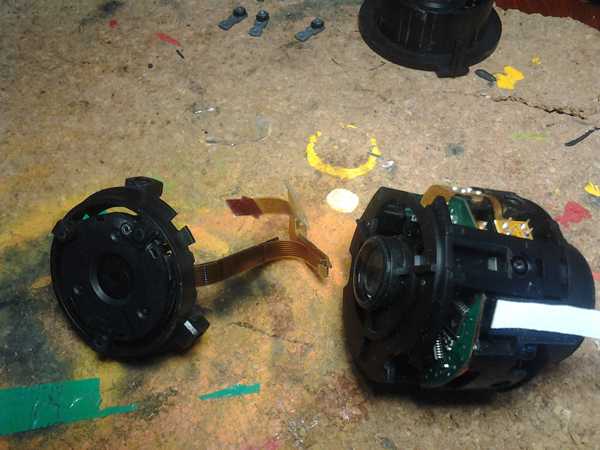 блок диафрагмы, зума и линза внутренней фокусировки
блок диафрагмы, зума и линза внутренней фокусировки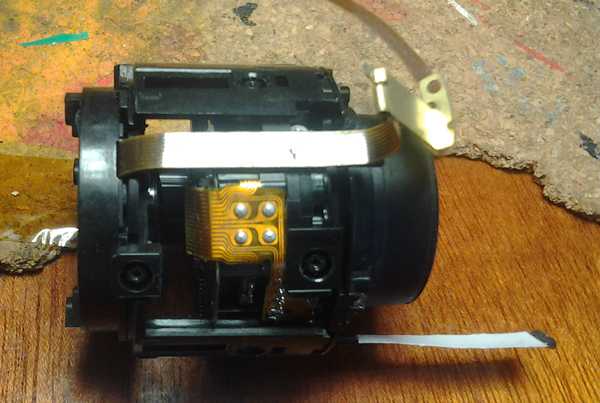 всё складывается однозначно
всё складывается однозначно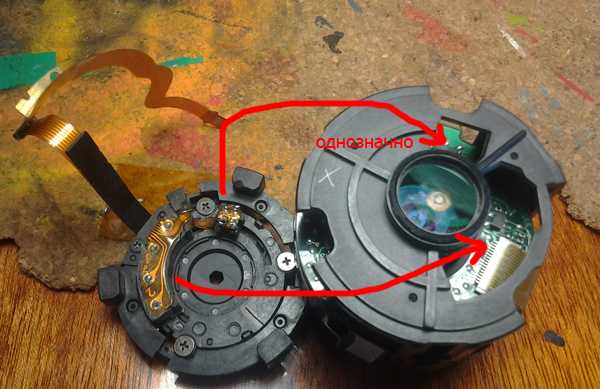 иначе не стыкуется
иначе не стыкуется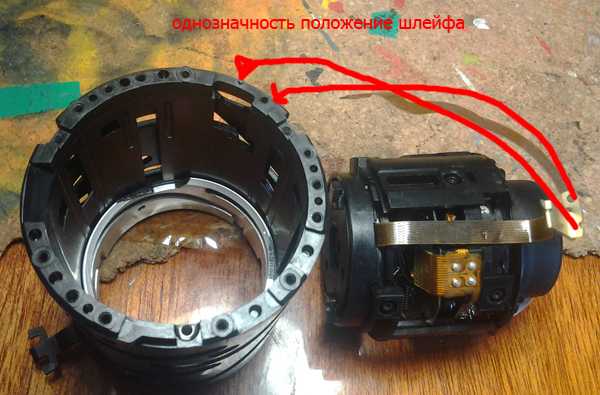 при установке этого блока в баррель будем привязываться к шлейфамдля шлейфа есть обнижение в барреле и место для крепления пластины
при установке этого блока в баррель будем привязываться к шлейфамдля шлейфа есть обнижение в барреле и место для крепления пластины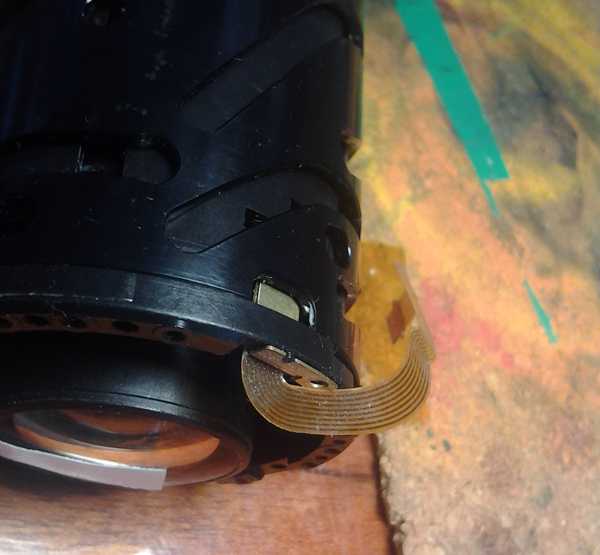 так правильно
так правильно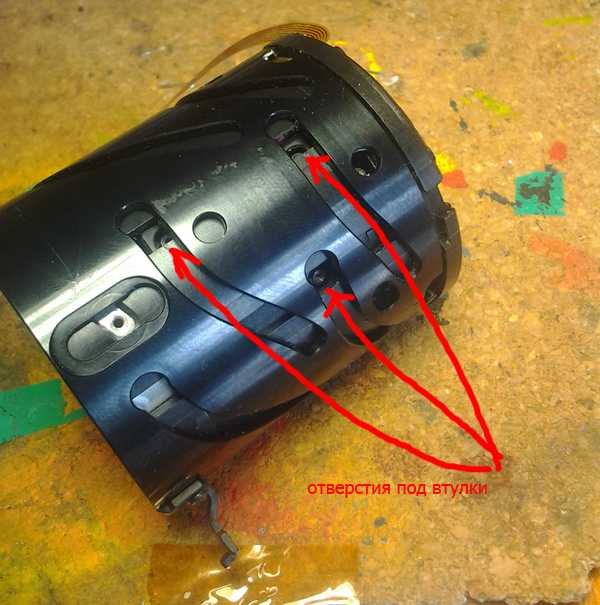 отверстия пол втулки на местахя уже не знаю, где втулки, искать не будускажу только, при разборке запоминайте, где какие стоялиони могут быть разной длины и диаметравообще втулки вещь тонкаяесли баррели затирают втулки ломаются, заменить нужно на оригинал, они непростой формы
отверстия пол втулки на местахя уже не знаю, где втулки, искать не будускажу только, при разборке запоминайте, где какие стоялиони могут быть разной длины и диаметравообще втулки вещь тонкаяесли баррели затирают втулки ломаются, заменить нужно на оригинал, они непростой формы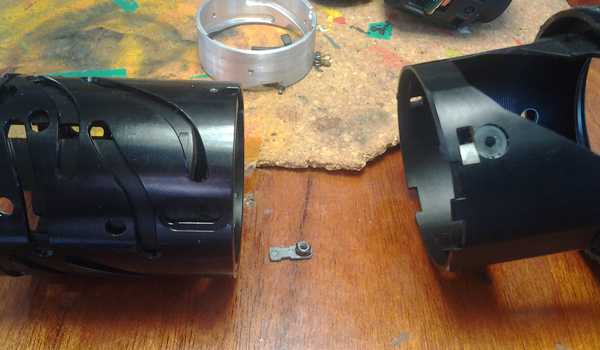 оправа передней линзы крепится к пластинкам, которые ходят вдоль оптической оси по продольному пазувнутри барреляза счёт этого передняя линза не вращается, как и должно бытьвопрос в том, куда поставить эти пластинки из какого паза должны выглядывать отверстия с резьбой
оправа передней линзы крепится к пластинкам, которые ходят вдоль оптической оси по продольному пазувнутри барреляза счёт этого передняя линза не вращается, как и должно бытьвопрос в том, куда поставить эти пластинки из какого паза должны выглядывать отверстия с резьбой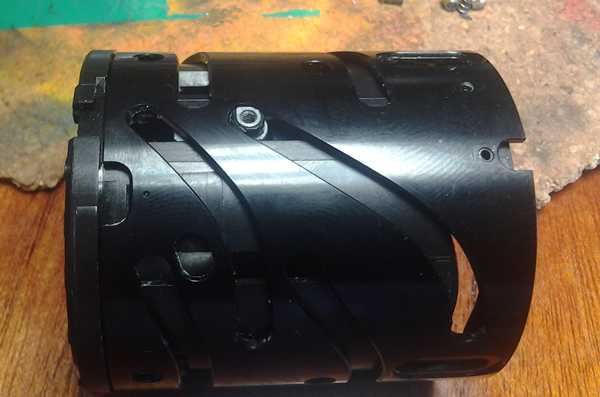 если паз правильный, втулки при вращении кольца от упора до упора должны быть в крайних положенияхвообще всё должно доходить при вращении до крайних положенийкрайнее положение, втулка вверху паза
если паз правильный, втулки при вращении кольца от упора до упора должны быть в крайних положенияхвообще всё должно доходить при вращении до крайних положенийкрайнее положение, втулка вверху паза если прикрутить оправу передней линзы правильно, будет большой вырез для рычага
если прикрутить оправу передней линзы правильно, будет большой вырез для рычага в нижнем положении рычаг даже попал в обнижение оправы для него, значит всё правильно
в нижнем положении рычаг даже попал в обнижение оправы для него, значит всё правильно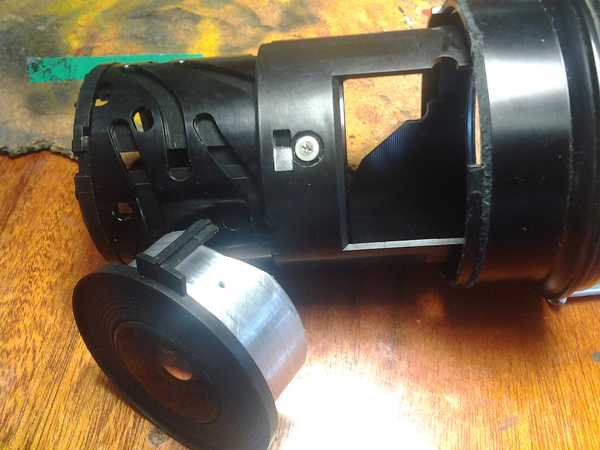 с другой стороны есть окно в котором будет ходить поводок линзы внутренней фокусировкиправда линзу с геликоидом так не вставить
с другой стороны есть окно в котором будет ходить поводок линзы внутренней фокусировкиправда линзу с геликоидом так не вставить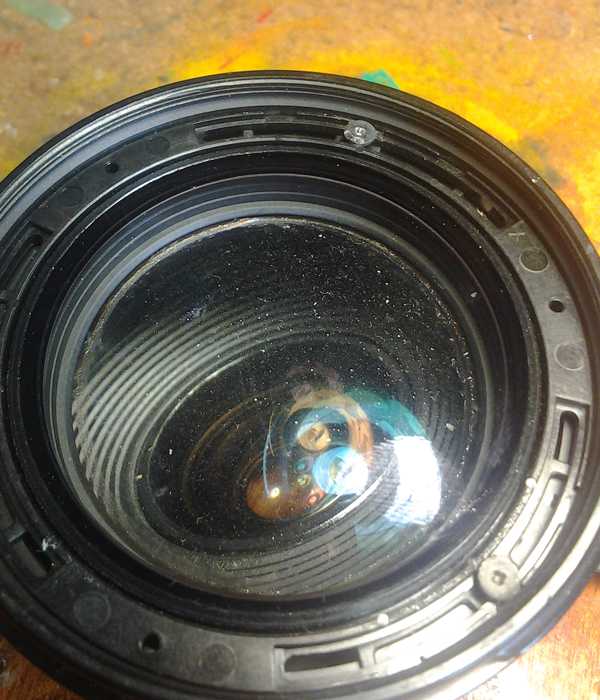 снимаем титульную наклейку и видим три винтаоправа с линзой кстати лежит на конусах, вращением линзы в оправе юстируется объектив
снимаем титульную наклейку и видим три винтаоправа с линзой кстати лежит на конусах, вращением линзы в оправе юстируется объектив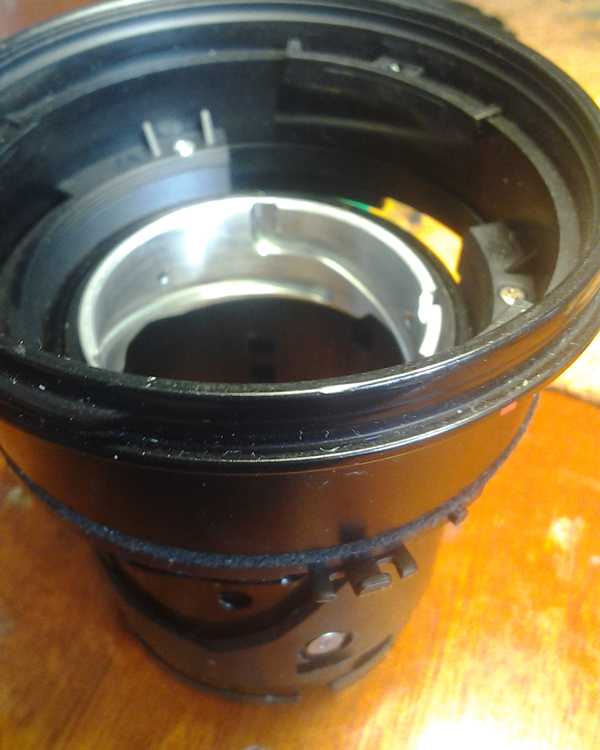 вынимаем линзу
вынимаем линзу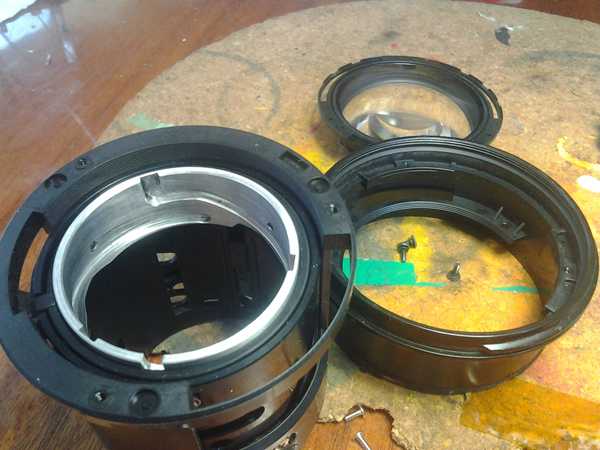 откручиваем оправу
откручиваем оправу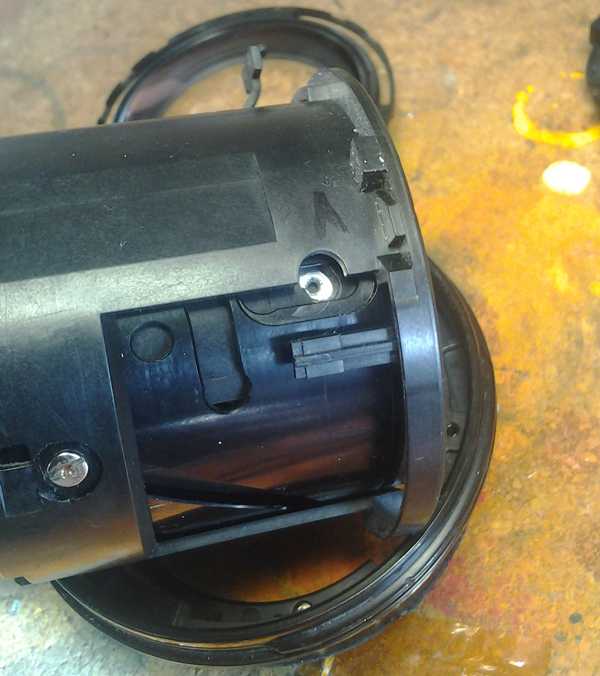 сначала вставляем линзу в геликоид, потом геликоид в баррельналичие поводка даёт однозначностьотверстие под втулку видно
сначала вставляем линзу в геликоид, потом геликоид в баррельналичие поводка даёт однозначностьотверстие под втулку видно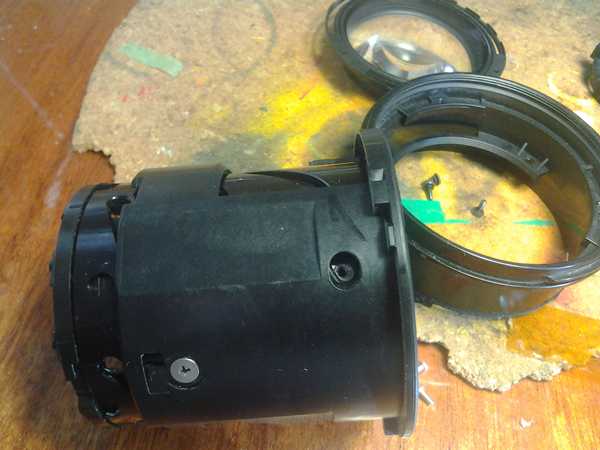 и здесь можно поставит втулку
и здесь можно поставит втулку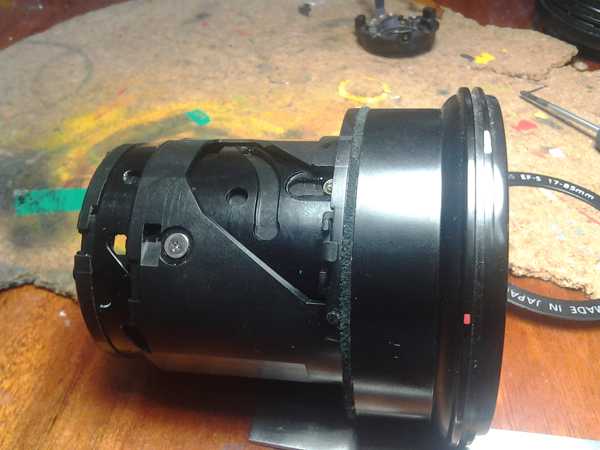 всё собираем и проверяем крайние положения
всё собираем и проверяем крайние положения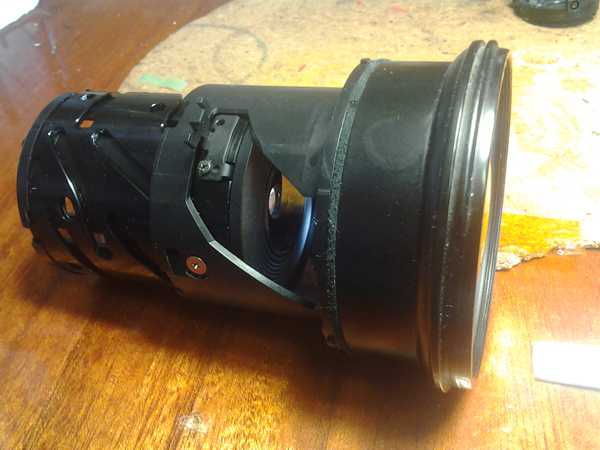 здесь всё сложилось
здесь всё сложилось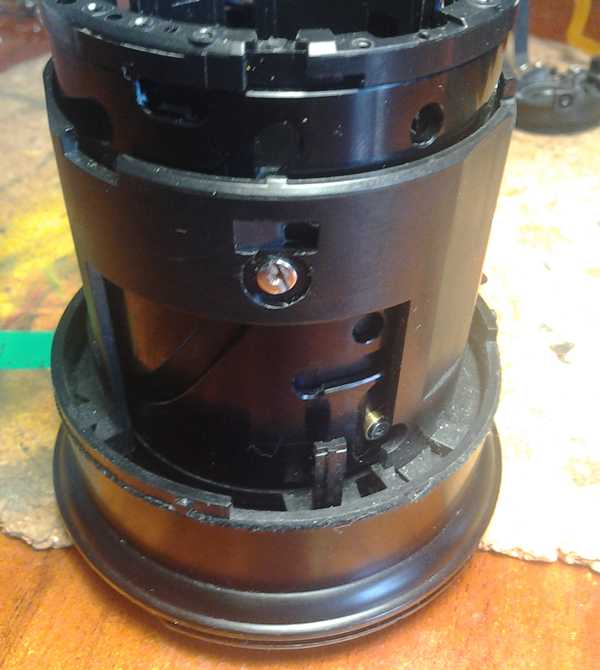 поводок линзы внутренней фокусировки в крайнем правом
поводок линзы внутренней фокусировки в крайнем правом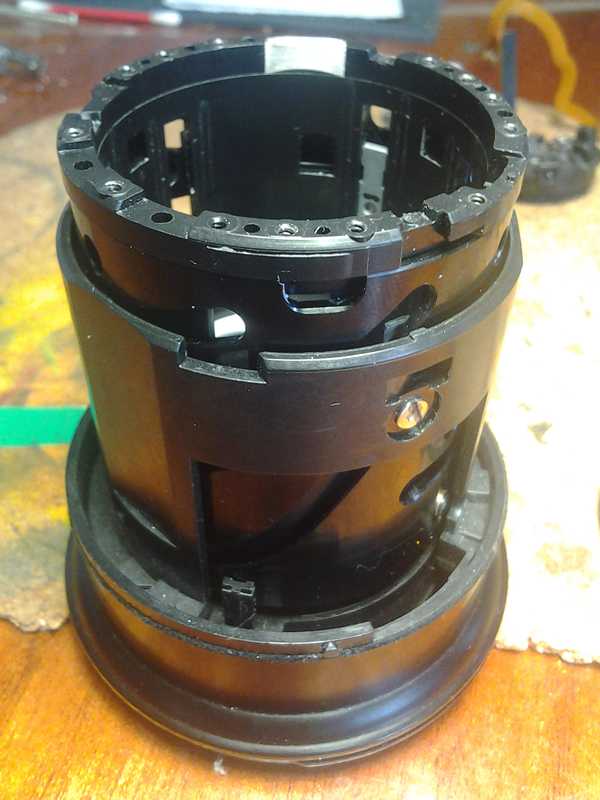 поводок в крайнем левом
поводок в крайнем левом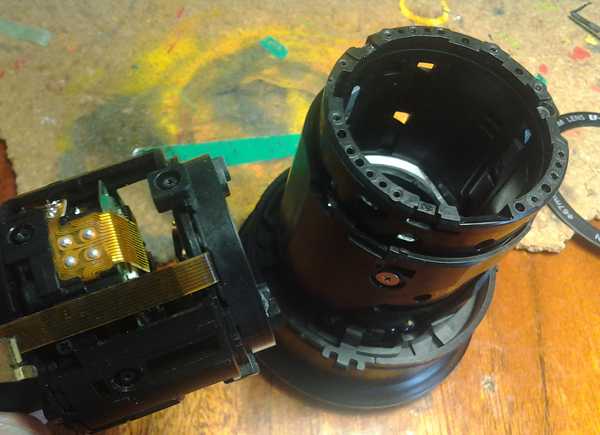 нет сложности установить стаб, диафрагму, уже проходили
нет сложности установить стаб, диафрагму, уже проходили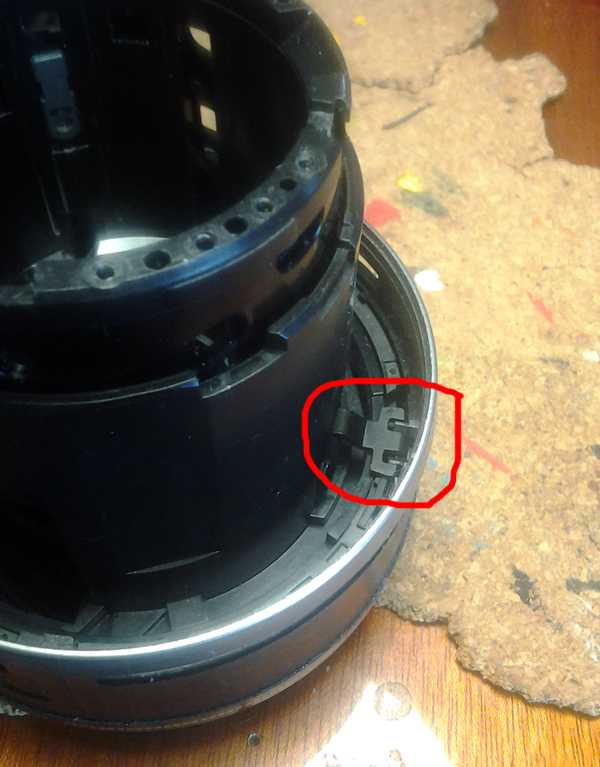 надеваем корпусное кольцо зумарычаг на барреле попадает в специальное место для него
надеваем корпусное кольцо зумарычаг на барреле попадает в специальное место для него поводок попадает в рога привода фокусировки
поводок попадает в рога привода фокусировки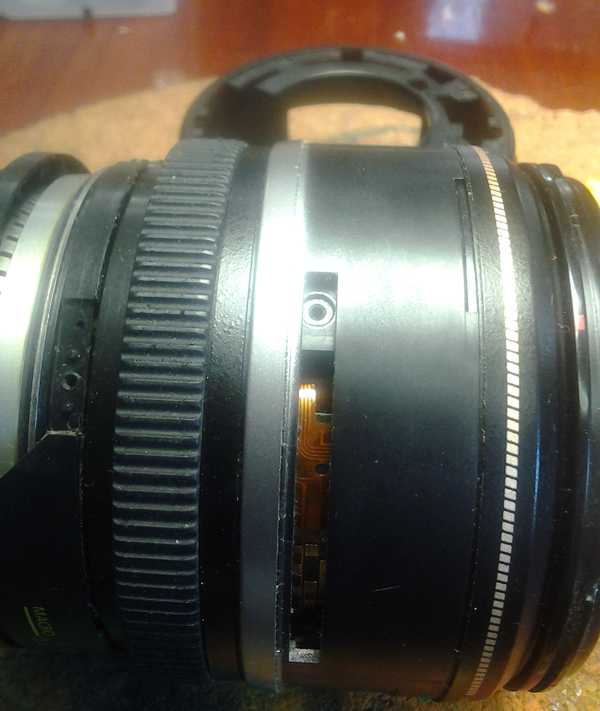 отверстия под втулки на месте
отверстия под втулки на месте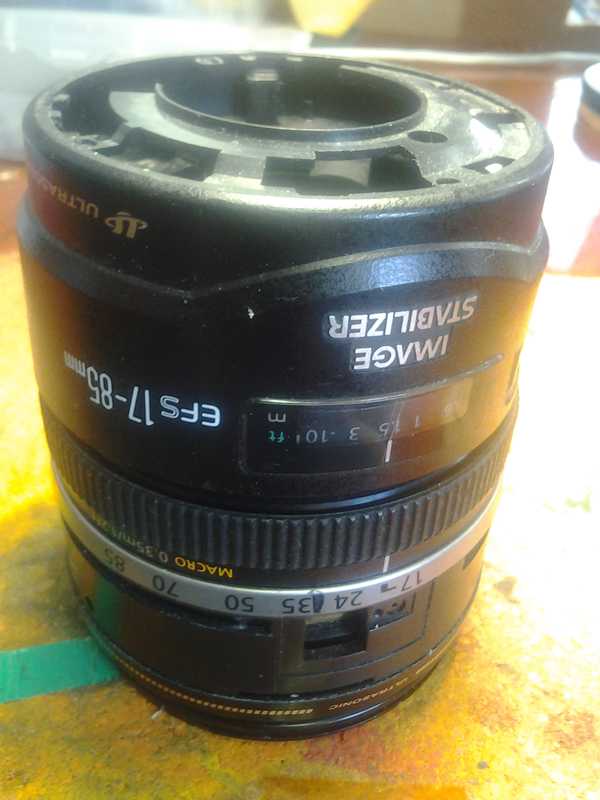 вот собственно и всёбольше для вас секретов у меня нетда и секреты ли это?всё просто, как мычаниеУспехов в фотографии
вот собственно и всёбольше для вас секретов у меня нетда и секреты ли это?всё просто, как мычаниеУспехов в фотографии
[url=https://lens-club.ru/articles/item/c_183.html]CANON 17-85 mm 1:4 — 5.6 IS USM конструкция и логика сборки
Комментарии:3.
2.
1.
Извините, но комментарии могут добавлять только авторизованные пользователи
